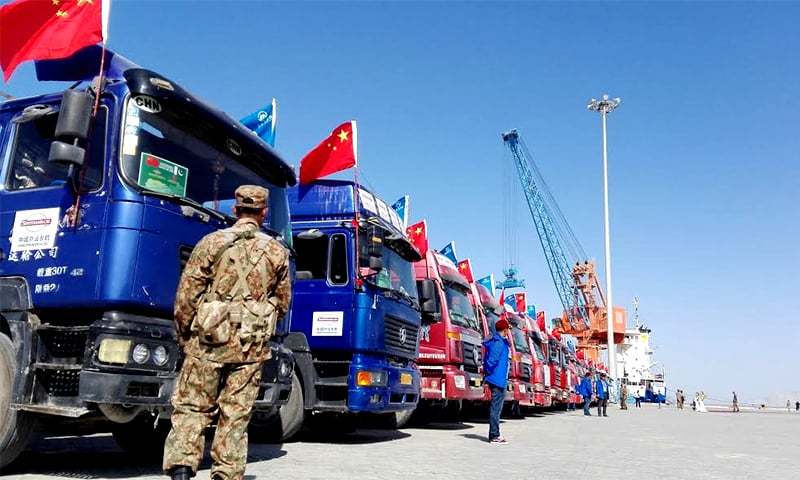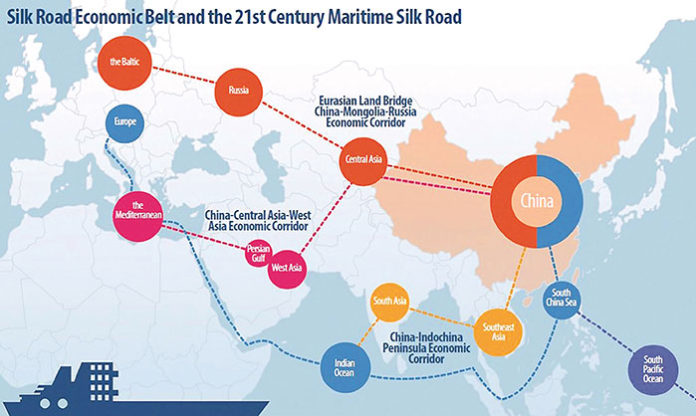China’s massive investment of more than $46 billion in CPEC is breathing new life into the ancient Silk Routes that connected the east and west centuries ago. The investment will bring huge long-term benefits to Pakistan and China as well as other countries in the region.
For the once sleepy remote fishing village of Gwadar, located on an isthmus on the coast of Balochistan close to the border with Iran, the massive ‘One Belt, One Road’ project will bring a new reality which not only opens up new opportunities for trade between east and west, but life as a prospering and important Deepwater port city.
It is yet too soon to tell what other countries will link up in some way with this project but the opportunities and benefits for regional and wider linkages are obvious. Rumours abound but the reality is that projects of such a massive scale take time to negotiate new and differing agreements to meet the needs of each partner.
At a meeting on the sidelines of the UN General Assembly in New York between the Prime Minister Muhammad Nawaz Sharif and Iranian President Hassan Rouhani, the later also expressed interest in participation. Iran is developing its Chahbahar Port just across the border to serve trade with Afghanistan. It would make sense for Iran and Pakistan to build linkages in port infrastructure to better serve the region.
British Foreign Secretary, Boris Johnson, in a recent visit to Pakistan said of CPEC, “I am very excited by the CPEC.” He added, “And I hope that British companies get to participate in the construction of this fabulous venture that will revive the ancient Silk Road as rebirth of trading caravans connecting East and West.” The Foreign Secretary also said that Karachi, another CPEC port, could rival the likes of Singapore or Shanghai as strategically important hub for trade and industry. Visiting foreign leaders are fond of rhetoric but are usually short on details. The details are for the business communities and government officials to explore and build on later. However, the point is that CPEC is attracting international attention and interest and this can be developed into something tangible given a little time.
Not all attention has been for the right reasons. Neighbourhood tensions remain strong, particularly with India. India’s attempts to isolate Pakistan are shortsighted, unreasonable and not successful. India’s determination to interfere with the success of CPEC is not only aimed at Pakistan, but is aligned with the United States’ concerns about the growing influence of China in the region, including the Indian Ocean. The Obama Administration’s ‘Pivot to Asia’ moving their focus towards Asia rather than the Middle East – is as much about containment of China as anything else. What will happen under the new Trump Administration remains to be seen but change seems unlikely given recent comments by the President-elect about China.
The strong relationship between China and Pakistan and the future benefits of CPEC, seems to have exacerbated the US concerns. However, all countries have a right to build trade and other linkages to the benefit of their own people. China is part of the region and building linkages is as much about geography and the regional economies as it is about geo-political reasons. It makes sense for Asian countries to build strong economic and security linkages in their own regions. However, that does not preclude retaining relationships with other countries like the United States or Europe. CPEC is very much at the ‘Heart of Asia’ and can bring benefits to all countries in this region given time and a strategic approach to trade to bring the world closer together economically. Anyone who has visited China over recent years can only be amazed at the speed and ability of China to build new infrastructure to link the country and bring modernity to once remote areas.

The first cargo arrived from China in a convoy of 100 trucks and the first ship has sailed from Gwadar. Exciting times for sure. The Pakistan Navy, being cognizant of its responsibility to make the maritime component of CPEC and Gwadar Port safe, deployed its ships and aircraft to provide security cover so as to ensure safe and secure transit of MV COSCO WILLINGTON and MV AL HUSSEIN in International waters. However, much is yet to be done in the coming years as infrastructure and facilities are completed and new partnerships are negotiated. Massive infrastructure projects of this kind take years to complete, but benefits flow at every stage. Meantime, all stakeholders should be building their own capabilities and capacities to enhance their role in this development. This includes the Pakistan Navy.
The Pakistan Navy plays an important role in CPEC and this will expand as the project continues to grow. Given the enormous challenges ahead in the Indian Ocean Region, the fleet and capacity must continue to expand to meet the challenges of securing Pakistan’s coastal region. Eight new submarines purchased from China will expand the Navy’s capability. Four of the new vessels will be constructed in China and be handed over to Pakistan by 2023 with the remaining four being constructed in Pakistan for handover by 2028. These are a substantial addition to PN’s fleet and will also bring jobs in the shipbuilding industry in Pakistan.
Submarines have been in the news recently with an incursion by an Indian submarine into Pakistan’s waters being detected. Naval defence experts say it was likely no coincidence that the incursion coincided with the timing of the first ‘CPEC” ship departing Gwadar. However, the Pakistan Navy was able to push the Indian vessel further out to sea. Other classes of new vessels are also under discussion and these, along with the existing fleet, plus new state-of-the-art weapons and equipment, will be vital for future maritime security.
Despite the importance of CPEC, coastal and Indian Ocean security, and the enormous benefits to Pakistan of marine-based industries and resources, the country still suffers from ‘sea blindness’. There is little awareness from the general public about what the maritime sector means to the economy of Pakistan. Nor is there much awareness of the various commands and agencies which play important roles in protecting resources, the lives of fishermen and coastal communities, and the coastal security. Although the coastline of Pakistan is not a particularly long one compared with some countries, it is located in a sensitive region. It also is home to substantial marine resources which should be protected for the benefit of the people of Pakistan.
Pakistan Navy continues its significant contribution to the Multinational Combined Task Forces 150 and 151 which are responsible to counter Maritime terrorism and anti-piracy operations off the coast of Somalia, and Horn of Africa respectively. The Navy is also conducting exercises with the Chinese Navy and other friendly countries to build cooperative strengths.
Pakistan Navy’s responsibilities for the protection of CPEC and ships using the port of Gwadar will continue to grow. This requires an enormous investment by the Government of Pakistan in modern ships, aircraft, equipment, facilities, weaponry, personnel and training. It is therefore imperative that the Government provides increased budget allocations to build the nation’s naval capacity and strategic strengths in the coming years so that the Navy and its aligned coastal agencies can fully play their role in maritime security and the future prosperity that CPEC will bring to the region.




